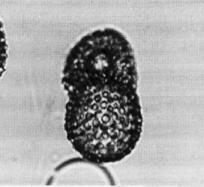 Centrobotrys
gravida Moore
Centrobotrys
gravida Moore Centrobotrys
gravida Moore
Centrobotrys
gravida MooreCentrobotrys gravida Moore, 1971, p.744, pl.5, fig.8
Internal [eucephalic] lobe heavy, spherical with no observable pores. The arrangement of the internal spines and axial rod appears to be as illustrated by Nigrini (1967, p.50) for C. thermophila. However, only the ventral spine forms a pronounced opening in the outer cephalic wall. Outer shell, heavy and rough with irregularly arranged subcircular pores. Pores vary in size but are generally largest in the equatorial region of the spherical to subspherical thorax. [Collar] stricture marked; thorax closed (Moore, 1971).
Maximum length 128-166 mm. Maximum breadth 75-113 mm (Moore, 1971).
Thick-walled form with closed inflated thorax (Riedel and Sanfilippo, 1978a).
C. gravida is more coarsely porous than other species of the genus, and differs in having a thicker shell (Sanfilippo et al., 1985).
The eucephalic chamber is located equidistantly from either side of the integrated ante- and post-cephalic chambers; the outline of the latter is generally semicircular, but in occasional specimens it tends to be bluntly pointed apically. The closed, globular thorax may be of the same size as the total cephalic structure, but is usually larger (Sanfilippo et al., 1985).
This species is found in middle early Oligocene assemblages from the tropical Pacific Ocean and the Caribbean region. The morphotypic first appearance of this species lies within the Theocyrtis tuberosa Zone and it evolves into Centrobotrys petrushevskayae within the same zone.
The ancestry of this species is not yet known, but C. petrushevskayae is clearly its descendant.
Definiton of the terms eucephalic and ante- and post-cephalic can be found in Petrushevskaya, 1965 (pp.82-83, fig.5).
Additional illustrations can be found in Riedel and Sanfilippo, 1978a, pl.4, fig.8.
Although there are similar forms with a lighter, more elongate thorax in the Upper Eocene and Oligocene, the heavy shell and nearly spherical thorax of this species make it distinctive. Its heavy shell, short stratigraphic range and general abundance in samples make it particularly useful in stratigraphic studies (Moore, 1971).